By Peter Krug – December 2002
Where does one start? Another trip to Nepal (my third) and
another adventure of a lifetime! In previous years I have trekked
into Annapurna Sanctuary and the Everest region both of which
proved to be very beautiful but were incredibly busy and I
fancied going somewhere quieter and I wanted to bag a peak if at
all possible.
In the end I chose to trek in the Rolwaling Valley which lies
just west of the Solu-Khumbu region (i.e. Everest National Park)
and the trip I chose offered the opportunity to bag two trekking
peaks – Ramdang and Parchemo. As this area could only be
accessed on a mountaineering permit we did not expect to meet too
many other trekking groups.
Having landed in Kathmandu and met the rest of our group,
which totalled seven plus our western trek leader and spent a day
sightseeing we were driven to the small town of Biriabesi where
we meet up with our crew. As we arrived the loads were being
shared out amongst the porters (some thirty or so). In addition
to the porters we had a sirdar, two or three climbing sherpas and
the cook crew. Our sirdar, Kunga had climbed Everest, Cho Oyu and
Annapurna and one of the climbing sherpas had climbed Lhotse. Our
cook had cooked for Chris Bonnington so we were in illustrious
company!
The first few days of the trek were generally fairly
easy-going as we walked the paths through the terraced fields of
the middle Himalaya. It was very pleasant passing through the
many villages such as Delangse, Bigu, Chilanka, Bulung, Jagat,
Simigaon, Douan and Beding. The terraced fields were very
impressive in their extent and the pictures that I took do not
reflect the steepness of the slopes being farmed. The crops were
mainly rice and millet. Wherever we were in between villages we
were encompassed by fairly thick-forested jungle, which provided
some relief from the heat of the day.
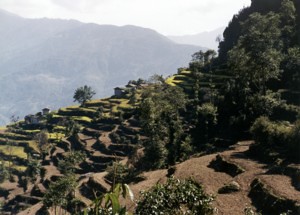 |
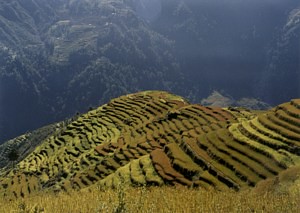 |
The villages were initially Buddhist as we approached the
Rolwaling area, then there was an area that was mainly Hindu and
then as we reached the upper Rolwaling valley we were back into
Buddhist territory.
On top of that we were treated to waterfalls, water powered
grain milling, wild monkeys, a new-born goat (like one minute
old), school visits, visited Bigu Gompa and a Nepalese “cultural
evening” when we were entertaining by the villagers doing their
traditional dances which we joined in and we reciprocated (if
that is the correct word!) by doing the “Okey Cokey.” We had to
climb the Tinsang La, which was 3,319 metres high but provided us
our first views of the Rolwaling area and a stunning first
sighting of Gauri Shankar.
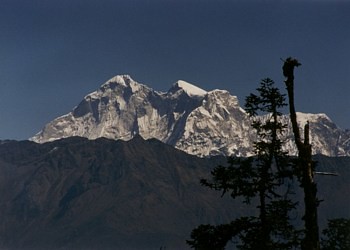 |
One interesting event which reflects on the current political
situation Nepal (decidedly dodgy) was the fact that we were
“taxed” by Maoists but they did give us a receipt! As we were
walking we were stopped by a couple of guys wearing army fatigues
but fortunately not armed. Our sirdar and leader told us to keep
on going whilst they negotiated. In the end we were taxed some
500 rupees per head. Incidentally, the receipt did help because
we were later stopped at another Maoist checkpoint and they let
us through without further charge once we waved our receipt.
However, all this provided the build up to the main event, which
were the bagging of some peaks and more importantly the crossing
of the Tesi Lapcha (5,750 m). It was the latter which was
effectively the crux of the trip because we had to get over this
pass into Solu-Khumbu otherwise we would have had to return from
whence we came. The peaks were optional.
By the time we reached Na some eight days into the trek we
were at over 4,000 metres and left the fields and forest of the
lower regions behind and the vegetation, which was scrubland. We
had also left the warmth behind and the nights were now decidedly
chilly!
We had a rest day in Na and the whole party took the
opportunity to visit the Tsho Rolpa, which provided a good
opportunity to acclimatise. This was a lake near the head of the
Rolwaling Valley, which was held back by moraine and is being
continuously monitored. The fear is that it would break through
this natural dam and wipe out the entire valley. Once again the
views were stupendous as we surrounded by Himalayan giants such
as Melungste, Tsoboje and Chukyima Go whilst before us lay our
route toward the Tesi Lapcha.
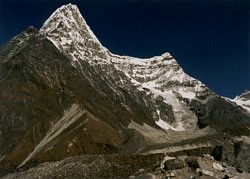 |
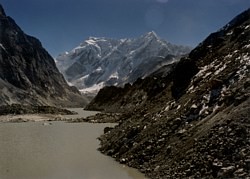 |
However, before all that we had an appointment with Ramdang
Peak and the next day we left Na, hung a right turn and climbed
up into a hanging valley where our base camp was situated. We had
another “rest-day” and again and naturally we were given another
opportunity to errr ‘acclimatise’ by doing exactly
the opposite! The “opportunity” was to climb the Yalung Ri, which
at 5,650 metres was going to provide a bit of a challenge.
It actually was not that bad. We left camp, walked up a ridge
to the foot of a glacier then donned plastic boots and crampons.
Then we roped up and off we went moving steadily up the glacier
weaving around a couple of crevasses. The final section to the
summit ridge was very steep and strenuous but the views from the
top, which included a sighting of Cho Oyu, were magnificent. We
were stopped about 40 metres short of the summit as the final
section involved rock-climbing in plastic boots which was not on
the agenda but all in all a good morning’s work!
The next day we moved up to high camp, which situated in a
stunning position on a glacier for our attempt on Ramdang Peak.
We had an unbelievably cold night (minus 30 Celsius) and set off
at about 6.00 a.m. and within an hour of setting off two of the
group had given leaving just three of us clients (two others had
decided not to go for the peak and were at base camp) to carry
the flag. The initial climb up from camp was pretty steep and
then we reached a plateau. However, we still had to climb a wall
of ice about 30 metres high, which had been fixed by the guides
the previous day, which involved jumaring.
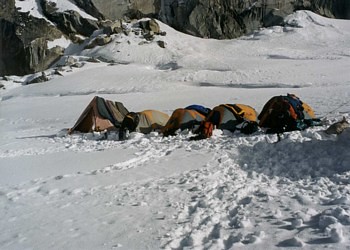 |
Once we had reached the top of this ridge we were onto a col,
which was at about 5,750 metres, and we could see the snow-capped
dome, which was the summit of Ramdang about three kilometres
away. Now we had a two and a half hour trudge over the glacier,
which was energy sapping before we reached the top to much joy!
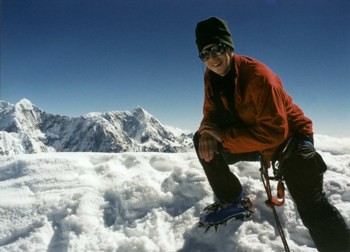 |
The rewards that were provided by our endeavours were incredible
mountain vistas and we could see Everest to the east and the
Annapurna massif to the west and countless other mountains. Then
there was the long march back to base camp which proved to be
exceedingly arduous.
The next couple of days were spent moving back down from
Ramdang, then up the valley, past the Tsho Rolpa and then weaving
in and out of the moraine of the Trakarding Glacier until we were
camped at the bottom of the Drolumbau Glacier. It is safe to say
that this was not the most pleasant campsite that I have stayed
at in view of the fact we were sleeping on mounds of rock! On our
walk-in we had to cope with fairly heavy snow, which prompted,
fortunately unfounded, worries about our attempt on the Tesi
Lapcha and sadly we passed a body right next to the path.
The next day was our big day as we were due to climb the Tesi
Lapcha and it proved to be quite a worrying day. Even from the
start I noticed that the group was struggling and this fact was
not unnoticed by our porters. It seemed to be a combination of
tiredness in some cases and a lack of acclimatisation in others.
Our route involved a scramble up a rocky gully, which for us
western tourists was “fixed” (but not for our nimble porters with
their 35-40 kilogram loads). Then next for a few hours we were on
mixed ground (sometimes rocky moraine and sometimes snow and ice)
as we progressed exceedingly slowly up the Drolumbau Glacier
passing below Parchemo until we reached the foot of the Tesi
Lapcha.
Incidentally, the group had decided not to climb Parchemo
because we felt that after the previous couple of days getting to
and over the Tesi Lapcha we would not have the energy left to
take this on.
After a short break we set off up the snow and then some rocky
ground until we reached another glacier. It was now mid-afternoon
and there was no sight of the top of the col. Our guides were
worried I could see it (probably because I was the only one that
was on top form) and I was trying to will the others to get a
move on. We weren’t roped up so in the end I just decided
to go for it and see if my pace would elicit some response from
my fellow trekkers. I use the term “pace” somewhat loosely
because I was not exactly sprinting up the mountain!
 |
| View from the Tesi Lapcha |
Anyway after several false summits I reached the top at 3.57
p.m just as the sun started to disappear behind the flanks of
Parchemo and as it did the temperature plummeted. I had plenty of
time to take in the views and to take some photographs whilst the
rest of the party started to arrive. Then in the gathering gloom
we dashed down the other side to our campsite a few hundred
meters below for yet another cold night.
Fortunately, now we could relax as we now made our way down
the Thame valley and towards warmth and sucked in the oxygen rich
air. We had had over a week of nighttime temperatures of well
below minus 15 Celsius and this had taken its toll on all of us.
Having spent the previous fortnight trekking in remote areas we
found ourselves in much more crowded surroundings and we met
loads of people both trekkers and locals as we approached first
Namche Bazaar and then Lukla which made me realise why I chose
the Rolwaling in the first instance! Mind you in spite of the
number of people the area is still very beautiful as we now in
the area, which included magnificent mountains such as Ama
Dablam, Thamserku and Kusum Kangguru.
In no time at all we were back to the relative comforts of
Kathmandu (a bath and a shave) and then it was time to go home
and to reflect on the events of the past month and also admire
the qualities of the magnificent sherpa people we had passed the
time with. The physical strength, fortitude and cheerfulness of
these people never fails to amaze me. Thanks guys!
